May 2018
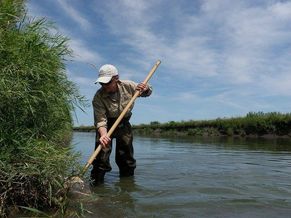 Ten years ago the Minnesota Pollution Control Agency (MPCA) began cycle 1 watershed wide monitoring efforts in the Root, Le Sueur, Mississippi River - Lake Pepin, Little Fork and Sauk River Watersheds. In May MPCA staff will begin Cycle 2 monitoring in these same watersheds to see if conditions are improving or declining.
From mid-June through September the MPCA’s north and south biological monitoring units will sample rivers, streams, and ditches for fish, macroinvertebrates (aquatic insects), habitat, and water chemistry at 85 (north) and 128 (south) unique stations across the watersheds. Efforts will also include follow up monitoring at 50 (north) and 40 (south) unique stations from 2017 in the Pomme de Terre, Snake, Redwood, Cottonwood, Blue Earth, Rapid, Lower Rainy and North Fork Crow River Watersheds. Heavy rains and high flows in the south and severe drought conditions in the north experienced during summer 2017 prevented completion of monitoring efforts. In addition, staff from both units will also continue efforts to monitor approximately 31 long-term biological monitoring network stations to track long-term conditions and changes.
The MPCA’s water quality monitoring unit will be collecting stream data from the same major watersheds being targeted in 2018 by the biological monitoring units. Dozens of lakes will also be monitored for routine condition monitoring both within these watersheds as well as spread across the state. Data collected will include nutrient information (nitrates, phosphorus, sediment etc.) in addition to dissolved oxygen, pH, conductivity, and secchi tube (clarity). To aid in the water quality sampling, local partners and citizen volunteers will also contribute by collecting water samples from lakes and streams in many watersheds. The data collected by both biological and water quality monitoring staff will feed directly into waterbody assessments of these systems anticipated in winter of 2020-21.
MPCA staff are in the final stages of publishing monitoring and assessment reports from watersheds monitored during the summer of 2015. The reports are scheduled to be published online this summer. These watershed reports include: Lac qui Parle; Minnesota River-Headwaters; Upper Wapsipinicon and Winnebago; Upper Iowa, Mississippi River-Reno, and Mississippi River-La Crescent; Roseau; Cloquet; Vermillion; and the Mississippi River-Grand Rapids. Once posted the reports can be found by typing in the watershed name on the MPCA’s website here: https://www.pca.state.mn.us/. More monitoring information is available online: Biological. Lakes. Streams. Citizen Volunteers.
Back to top
|
As spring arrives and watershed professionals’ thoughts turn toward construction, the Clean Water Partnership (CWP) Loan program is continuously accepting loan applications for nonpoint source pollution implementation projects. These 0% interest loans are flexible and can help fill funding needs, such as matching other federal or state grants. The entire implementation period and repayment period is completely interest free. Borrow now, implement the project for three years, and pay the loan back over 10 years. Funds can be available in as little as 60 days.
Eligible projects include:
- Urban green infrastructure such as rain gardens, green roofs, and rainwater reuse
- Buffers
- Septic system upgrades and replacements
- Technical assistance
- Equipment such as street sweepers and conservation tillage equipment
- Feedlot upgrades or replacements
- Any Best Management Practices (BMPs) to address nonpoint source pollution
Local government units can use these funds to implement the work or loan the funds to a resident to implement the projects. This is a great opportunity to fund projects that may not be the best fit for grant applications, such as addressing inflow and infiltration issues or upgrading and replacing septic systems.
Any local government unit with revenue-generating capability is eligible to apply or they can sponsor a loan for another entity, such as a soil and water conservation district, to complete the project. The process is quick and easy. For more information contact Cindy Penny at 651-757-2099 or cynthia.penny@state.mn.us. Or visit the MPCA website at www.pca.state.mn.us/cwp-loans.
Back to top
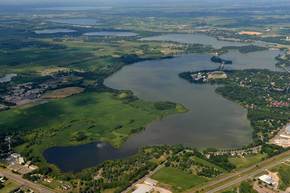 The new 319 Small Watersheds Focus Program is looking for interested
watersheds to partner with the Minnesota Pollution Control Agency (MPCA) in
developing a long-term roadmap to support comprehensive implementation on a
small-scale watershed.
The MPCA seeks ten small watersheds to develop a detailed
Focus Grant Plan following the EPA’s Handbook
for developing watershed plans to restore and protect our waters. The
selected watersheds will be prioritized to receive four,
four-year grant awards spanning 16 years. Funds will be
used to implement projects outlined in the grant workplan,
provide a steady source of funding, focus implementation efforts, and achieve
measurable water quality improvements on a specific waterbody. (Aerial photo by Bruce Jaeger: Willmar chain of lakes in upper Hawk Creek watershed.)
Eligible applicants are public and private entities, including local governmental units such as soil and water conservation districts, watershed districts, watershed management organizations, tribal authorities, cities, counties, regional development centers, local school systems, colleges and universities, local nonprofit organizations, state agencies, organizations established by joint powers agreements, and for-profit groups and individuals interested in leading a non-point source project.
More information is available on the project webpage. If you have questions, contact Cindy Penny at 651-757-2099, cynthia.penny@state.mn.us, or Greg
Johnson at 651-757-2471, gregory.johnson@state.mn.us.
Back to top
|
 The 10th Minnesota River Congress will be Thursday, May 17 at the Kato Ballroom in Mankato. The Congress begins with a Networking Fair at 4 p.m., followed by dinner at 6 p.m. At 6:30 there will be a brief business meeting to learn about activities across the basin and recruit board members. A 7 p.m. program will include a Minnesota River report by Chris Lenhart of the U of M, a presentation by "Waterway" Jay Gustafson about his epic paddling adventures, "Watching the river grow" by Ron Bolduan and Scott Kudelka, and "Increasing soil organic matter" by Ann Lewandowsk of the U of M.
The new Minnesota River Congress website provides
details about the and registration. About 75 people attended the ninth Congress Nov. 16 at
Jordan, reviewing progress on resolutions, interest network teams
and board activities. For more
information contact Scott Sparlin, sesparlin@gmail.com, 507-276-2280. Friends of the Minnesota River Valley flyer.
Back to top
|
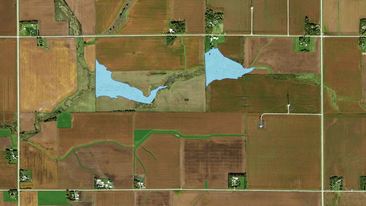
The largest project in the Cedar River
Watershed District’s nearly $8.4 million Capital Improvement Plan is
nearing construction later this month in the upland area of Dobbins Creek’s
north branch, southeast of Brownsdale. A complex
project, Dobbins 1 has been in the works for more than two years with multiple
landowners and requiring a couple dozen signatures, said Cody Fox, CRWD project
manager. Dobbins 1 will consist of two water-detention structures or earthen
dams on private land. (Depicted in aerial photo).
Dobbins
1 is targeted in the upland area of North Dobbins, a stream highly prone to
flash flooding. North Dobbins flows into the South Branch of Dobbins Creek at
Austin’s Jay C. Hormel Nature Center before becoming East Side Lake. Dobbins
then flows into the Cedar River State Water Trail in Austin’s Driesner Park. Once
completed it is expected to reduce peak flood flows by 82 percent
immediately downstream from its structures, keeping about 134 tons of sediment
and 218 pounds of phosphorus per year out of Dobbins.
Back to top
|
Filing for SWCD elections begins May 22
The filing period for Soil and Water Conservation District board candidates begins May 22 through June 5. Click here for more information. Nancy Benson has served on the Wadena SWCD Board of Supervisors for the past 10 years, and says that it’s one of the best investments of her time. “We can’t make more land, so we have to take care of what we have,” Benson says. “Serving your soil and water conservation district is such a worthwhile task – you gain something, you give back to your community, and you’re working with wonderful people who all care about conservation. If you’re considering running but are unsure, know that there are wonderful leadership workshops and trainings that will help you become a board member who is a true asset to your community.” - MASWCD May newsletter.
Lake Pepin restoration meeting video posted online
More than 100 people attended the second public meeting for Lake Pepin restoration hosted April 4 by the U.S. ArmyCorp of Engineers. Multiple restoration alternatives were presented for public feedback. The next public meeting is expected this fall. Multiple recordings of the public meeting were combined into a full-length video that shows the project presentation and public Q &A.
Watershed network hears new focus for 319 program
About 20 people attended the 17th watershed networking and learning event April 26 at the Mankato Pizza Ranch. Cindy Penny and Greg Johnson of the MPCA gave an overview of the Section 319 Small Watersheds Focus Program. They are inviting letters of interest for a pilot program in 10 small watersheds this year. Jill Sackett-Eberhart and Jenny Mocol-Johnson, BWSR, gave updates on the progress of One Watershed-One Plan in the Watonwan and Cannon watersheds.
Chippewa watershed project coordinator applications due May 16
The Chippewa River Watershed Project is seeking a Watershed Coordinator. Cover letters and resumes to apply for the Chippewa River Watershed Project coordinator are due by Wednesday, May 16. More information is available online or by contacting Jennifer at 320-3321-1718, or jennifer.hoffman@chippewariver.org.
Webinar topic: Manure impact on soil properties
A May 18 webinar will focus on the relationships of land applied livestock manure and other organic materials to soil aggregation, resistance to erosion and microbial dynamics in consideration of field characteristics. The webinar will focus on effects that go beyond manure's capability to provide NPK to crops, such as nutrient cycling and soil physical and biological properties. Presenters: Linda Schott and Charles Wortmann, University of Nebraska - Lincoln. 1:30 p.m., May 18. Read more or register for the webinar...
Extension preparing report on cover crops and manure project
The North Central Water Network posted a synopsis of the Extension report on the
cover crops and manure project. "Effects of liquid manure injection into a winter rye cover crop: on-farm trials" was authored by Les Everett, U of M Water Resources, and Randy Pepin, CenterU of M Extension. They concluded that in central and southern Minnesota it is feasible to establish cereal rye cover crop after corn silage or soybean harvest, inject liquid manure, capture root-zone nitrate with the rye, and deliver sufficient nitrogen to the subsequent corn crop. A more comprehensive article
will be posted later this spring or summer.
Back to top
The Minnesota Pollution Control Agency (MPCA) submitted Minnesota’s 2018 proposed Impaired Waters List to the U.S. Environmental Protection Agency (EPA) for approval on April 4, 2018.
The MPCA posted a draft version of the list for public viewing in November 2017. After a series of public meetings and a formal comment period, the agency made a few changes to the draft list based on public input. These changes consisted of removing two impairments from the list and adding three.
The MPCA has not finalized methods for identifying waters used for production of wild rice or for assessing impairment of waters based on the existing wild rice-related standard. Consequently, the draft 2018 303(d) Impaired Waters List does not include any waters assessed as impaired for the sulfate wild rice standard. The MPCA is in the midst of an effort to revise the sulfate standard to protect wild rice and will develop an assessment approach once that rulemaking is complete.
To view public comments, responses to comments, the Guidance Manual, or the 2018 proposed Impaired Waters List go to the Impaired Waters List webpage. For questions, contact Miranda Nichols at 651-757-2614, or by email at miranda.nichols@state.mn.us.
Back to top
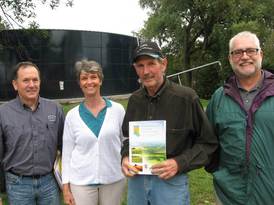
Marcie
Weinandt retired May 1 from the Dept. of Agriculture after working more
than 30 years on rural development, agriculture and water
resources, impacting local to national policy with partners in non-profits,
educational institutions and local, state, tribal and national governments.
In the last five years she worked on the development
and implementation of the Minnesota Agricultural Water Quality Certification
Program. Photo: Water quality certification award at a Stearns County dairy
farm, (L-R): Mark Lefebvre, Marcie Weinandt, Dean Klaverkamp, Dennis Fuchs.
"It's been a great run. I've had some fabulous
opportunities in diverse rural and water quality areas," Marcie
says. Working with county SWCDs, the Water Quality Certification Program
has been growing steadily, now with more than 1,044 new conservation
practices across 354,492 acres on 555 farms. Two recent staff hires will
continue to work with program director Brad Redlin. "It's all in
good hands," she says.
Prior to MDA Marcie was CEO of the Midwest Assistance
Program, a nine-state organization providing water and waste water technical
assistance to small rural communities, policy director for the Rural Policy
Research Institute in Washington DC, Minnesota Rural Partners Director,
Renville County Commissioner and serving on the Citizens’ Advisory Committee
for the Minnesota River. "I started my career writing the first Local
Comprehensive Water Plans for six southwestern counties in 1988," she
says.
Now with more time Marcie plans to visit out-of-state
grandchildren more often, and volunteer with political campaigns. Living in
Mounds View she will continue on the citizens advisory committee for the Rice
Creek Watershed.
Back to top
|
The Dept. of Agriculture's proposed Groundwater
Protection Rule was published in the State Register April 30 launching an
80-day public comment period. The goal of the rule is to work with local
farmers to reduce elevated nitrate levels in groundwater and ensure Minnesota
residents have clean, safe, and reliable drinking water supplies.
Nitrate is one of the most common contaminants in Minnesota's
groundwater; elevated nitrate levels in drinking water can pose serious health
concerns for humans. The proposed rule, which is based on the input of the
farmers and landowners who the rule would apply to, would regulate the use of
nitrogen fertilizer in areas of the state where soils are prone to leaching and
where drinking water supplies are threatened.
Starting April 30 public comments on the rule can be made on the
Office of Administrative Hearings website at www.mn.gov/oah. The rule is part of the
state’s overall Nitrogen Fertilizer Management Plan developed with broad
stakeholder input over five years and implemented in 2015. More
information on the rule and the NFMP is available at www.mda.state.mn.us/nfr.
Back to top
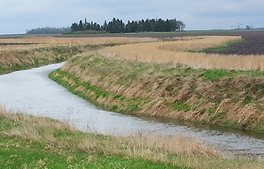
Buffer
strips are the top water-quality improvement strategy in the South Fork Crow
River watershed, according to new draft reports released April
17 by Minnesota Pollution Control Agency (MPCA). The agency and local
partners are seeking public comments through May 16 about the buffer strip
implementation efforts and other protection and restoration strategies.
The Total Maximum Daily Load report establishes the amount of
each pollutant that a water body can accept and still meet water quality
standards. It identifies 42 stream segments failing to meet water quality
standards due to low dissolved oxygen, high phosphorus levels, and altered
hydrology. The report also shows that field drainage and tile drainage to
waterways, especially Buffalo Creek and the South Fork Crow River, are
important factors in stream impairments.
The Watershed Restoration and Protection Strategy summarizes
past efforts to monitor and improve water quality, and identifies future
strategies for restoring and protecting the watershed’s water quality. The
WRAPS report identifies areas along Silver Creek and the South Fork Crow
River, upstream of Hutchinson, where healthy buffer strips are helping to
improve water quality. Other suggested strategies include increasing water
storage, proper culvert and bridge sizing, adding riparian buffers with deep
roots, and restoring connectivity and natural stream channels.
The South Fork Crow River watershed is located in
south-central Minnesota and encompasses parts of Kandiyohi, Renville, Meeker,
McLeod, Sibley, Wright, Carver, and Hennepin counties. The South Fork Crow
River joins with the North Fork Crow at Rockford and then joins the
Mississippi River near Dayton.
The reports are available at: www.pca.state.mn.us/water/watersheds/south-fork-crow-river,
or at the MPCA’s St. Paul office, at 520 Lafayette Road North. The MPCA
encourages those interested in the South Fork Crow River Watershed to review
and provide feedback on the reports. Comments may be submitted to Scott
Lucas, MPCA, 7678 College Road, Baxter, MN, 56425, or by e-mail to, scott.lucas@state.mn.us
by 4:30 p.m. on May 16, 2018. For more information, contact Scott at
218-316-3874, or toll-free at 800-657-3864.
Written comments must indicate whether they pertain to the
South Fork Crow River watershed’s TMDL or WRAPS report. They should clearly
state the action you wish the MPCA to take, including references to sections
of the report that you believe should be changed; please provide specific
reasons supporting your position. More
information is available on the MPCA’s
watershed web pages.
Back to top
|
|